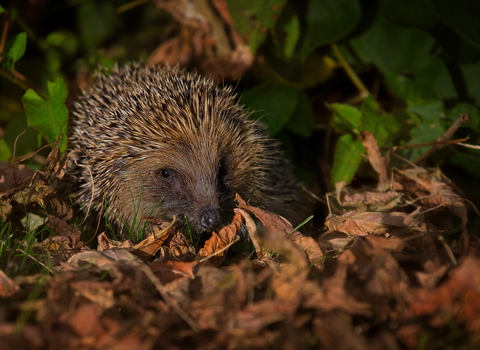
Hedgehog © Jon Hawkins - Surrey Hills Photography
European hedgehog
Scientific name
Erinaceus europaeusWhen to see
April to OctoberSpecies information
Category
Statistics
Length: 15-30cmTail: 1-2cm
Weight: up to 2kg
Average lifespan: 2-3 years
IUCN Red List for British Mammals - vulnerable to extinction.
About
Round, brown and famously covered in spines, the hedgehog is the UK’s most familiar wild animal. They can be spotted in parks and gardens where bushes provide the perfect daytime getaway! They love long grass full of insects to feast on once the sun has set.Hedgehogs eat all kinds of invertebrates, as well as amphibians, birds' eggs and anything else they can catch; they particularly like big, crunchy beetles and earthworms, making them a gardener's best friend. Hedgehogs hibernate over winter, from about November to April, in a nest of leaves or logs called a 'hibernaculum'.
How to identify
A unique and unmistakeable animal, the hedgehog is small, brown and round, with yellow-tipped spines over its back, and a fur-covered face. Mostly nocturnal, you may see or hear one snuffling around the garden. Or look out for the signs of hedgehogs, such as medium-sized, black droppings full of insect bits on the lawn.Distribution
Widespread, found throughout the country in a variety of habitats, though absent from some Scottish Islands. A large proportion of the hedgehogs on Alderney are blonde!In our area
The Isles of Scilly doesn't have any native land mammals, but you still might encounter introduced species including hedgehogs. St Mary's s home to a population of hedgehogs that can be spotted right across the island. The Garrison campsite, Peninnis, Hugh Town and anywhere with gardens are hotspots. They are believed to have been introduced to St Mary’s in the 1980s. Many welcome this charismatic species, especially as a gardener’s friend, however hedgehogs can pose a threat to shrews, ground nesting birds and seabirds, predating on eggs and young chicks. A hedgehog control programme has been carried out in the Outer Hebrides on North Uist. At present, hedgehogs don't appear to have a negative impact that would warrant intervention. In addition, they are considered ‘vulnerable’ on the IUCN red list and have suffered significant declines across the UK.
Did you know?
Hedgehogs are known for their ability to roll themselves into a ball of spines when threatened. These spines are actually modified hairs and the average hedgehog has about 7000 of them, which can be raised using powerful muscles along their back.Watch
Hedgehog (https://vimeo.com/473378502)
Hedgehog by Stuart Edmunds
The Isles of Scilly doesn't have any native land mammals, but you still might encounter introduced species including hedgehogs. St Mary's s home to a population of hedgehogs that can be spotted right across the island. The Garrison campsite, Peninnis, Hugh Town and anywhere with gardens are hotspots. They are believed to have been introduced to St Mary’s in the 1980s. Many welcome this charismatic species, especially as a gardener’s friend, however hedgehogs can pose a threat to shrews, ground nesting birds and seabirds, predating on eggs and young chicks. A hedgehog control programme has been carried out in the Outer Hebrides on North Uist. At present, hedgehogs don't appear to have a negative impact that would warrant intervention. In addition, they are considered ‘vulnerable’ on the IUCN red list and have suffered significant declines across the UK.
